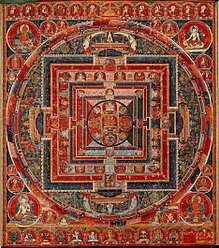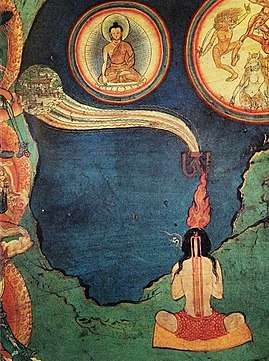Deity yoga
Deity yoga (Tibetan: lha'i rnal 'byor; Sanskrit: Devata-yoga) is a practice of Vajrayana Buddhism involving identification with a chosen deity through visualisations and rituals, and the realisation of emptiness. According to the Tibetan scholar Tsongkhapa, deity yoga is what separates Buddhist Tantra practice from the practice of other Buddhist schools.[1]
| Part of a series on |
| Vajrayana Buddhism |
|---|
 |
|
Traditions Historical traditions:
New branches:
|
|
History |
|
Pursuit |
|
Practices
Fourfold division: Twofold division: Thought forms and visualisation: Yoga:
|
|
Festivals |
|
Tantric texts |
|
Ordination and transmission |
Deity yoga involves two stages, the generation stage and the completion stage. In the generation stage, one dissolves the mundane world and visualizes one's chosen deity (yidam), its mandala and companion deities, resulting in identification with this divine reality.[2] In the completion stage, one dissolves the visualization of and identification with the yidam in the realization of sunyata or emptiness. Completion stage practices can also include subtle body energy practices.[3]
Overview
.jpg)
Purpose
The purpose of Deity yoga is to bring the meditator to the realization that the yidam or meditation deity and the practitioner are in essence the same, that they are non-dual (advaya). According to John Powers. "Deity yoga is a technique for becoming progressively more familiar with the thoughts and deeds of a buddha, until the state of buddhahood is actualized through repeated practice."[4]
According to Gyatrul Rinpoche, the point of this practice is to "understand your buddha nature, which is the very essence of your being" and is "intrinsically present" in all beings.[5] The fact that the deity is a reflection of qualities already inherent in the practitioner is what makes this practice different than mere deluded or wishful thinking.[4]
The yidam generally appears in a mandala and the practitioner visualizes himself or herself and their environment as the yidam and mandala of their Deity Yoga practice. This visualization method undermines a habitual belief that views of reality and self are solid and fixed, enabling the practitioner to purify spiritual obscurations (Sanskrit: klesha) and to practice compassion and wisdom simultaneously:
Deity Yoga employs highly refined techniques of creative imagination, visualisation, and photism in order to self-identify with the divine form and qualities of a particular deity as the union of method or skilful means and wisdom. As His Holiness the Dalai Lama says, "In brief, the body of a Buddha is attained through meditating on it".[6]
Visualisation
Representations of the deity, such as a statues, paintings (Tibetan: thangka), or mandalas, are often employed as an aid to visualization in both the Generation Stage (Tibetan: Kye-rim) and the Completion Stage (Tibetan: Dzog-rim) of Anuttarayoga Tantra. The mandalas are symbolic representations of sacred enclosures, sacred architecture that house and contain the uncontainable essence of a yidam. In the book, The World of Tibetan Buddhism, the Dalai Lama describes a mandala: “This is the celestial mansion, the pure residence of the deity.”
Yidams
In the Vajrayāna Buddhism of Tibet and East Asia, which follow the Nālandā Tradition of India-Tibet-China, there are fifteen major tantric sādhanās, each connected with a specific yidam:
All of these are available in Tibetan form, many are available in Chinese, and some are still extant in ancient Sanskrit manuscripts.[7]
Mandalas

Mandalas are used as an aid in realizing the inner ground:
[E]xternal ritual and internal sadhana form an indistinguishable whole, and this unity finds its most pregnant expression in the form of the mandala, the sacred enclosure consisting of concentric squares and circles drawn on the ground and representing that adamantine plane of being on which the aspirant to Buddhahood wishes to establish himself. The unfolding of the tantric ritual depends on the mandala; and where a material mandala is not employed, the adept proceeds to construct one mentally in the course of his meditation.[8]
Generation stage
In Tantric Buddhism, the generation stage (T:kye rim, Wyl., bskyed rim; S:utpatti-krama) is the first phase of Deity yoga. It is associated with the 'Father Tantra' (Wylie: pha-rgyud; pa-rgyud) class of anuttara-yoga-tantras of the Sarmapa or associated with what is known as Mahayoga Tantras by the Nyingmapa. An example of a 'Father Tantra' is the Guhyasamāja Tantra.
The generation stage engages creative imagination or visualization as an upaya or skillful means of personal transformation through which the practitioner (sadhaka) either visualizes a meditational deity (yidam) or refuge tree before themselves in front generation, or as themselves in self generation, to engender an alteration to their perception and/or experience of the appearance aspect of reality.[9] One practices oneself in the identification with the meditational Buddha or deity (yidam) by visualisations, until one can meditate single-pointedly on being the deity.[note 1]
According to Tsongkhapa, throughout the various stages of visualization one is to maintain the cognition of emptiness and "one trains in [causing] everything to appear as like illusions".[10] Reginald Ray writes that during the process of yidam visualization, the deity is to be imaged as not solid or tangible, as "empty yet apparent", with the character of a mirage or a rainbow.[11]
Four purities
In the generation stage of Deity Yoga, the practitioner visualizes the "Four Purities" (Tibetan: yongs su dag pa bzhi; yongs dag bzhi)[web 1] which define the principal Tantric methodology of Deity Yoga that distinguishes it from the rest of Buddhism:[12]
Front generation
Front generation is a form of meditative visualization employed in Tantric Buddhism in which the yidam is visualized as being present in the sky facing the practitioner as opposed to the self-identification that occurs in self generation. According to the Vajrayana tradition, this approach is considered less advanced, hence safer for the sadhaka, and is engaged more for the rites of propitiation and worship.[13]
Self generation
Self generation is a form of meditative visualization employed in Tantric Buddhism in which the yidam is invoked and then merged with the sadhaka as an upaya of self-transformation. This is as opposed to the method of front generation. According to the Vajrayana tradition, self generation is held to be more advanced and accompanied by a degree of spiritual risk from the siddhi it may rapidly yield.[14]
An important element of this is "divine pride", which is "the thought that one is oneself the deity being visualized."[15] According to John Powers, "divine pride is different from ordinary, afflicted pride because it is motivated by compassion for others and is based on an understanding of emptiness. The deity and oneself are both known to be empty, all appearances are viewed as manifestations of the luminous and empty nature of mind, and so the divine pride of deity yoga does not lead to attachment, greed, and other afflictions."[16]
Completion stage

The completion stage (Tibetan:dzok-rim, (Wyl: rdzogs rim); Sanskrit:saṃpanna-krama) is the second stage of deity yoga. Completion stage may also be translated as "perfection stage" or "fulfillment mode." In the completion stage one engages in practices associated with the subtle body energies and dissolves the deity into sunyata.
The practitioner can use either the path of method (thabs lam) or the path of liberation ('grol lam).[17] At the path of method the practitioner engages in subtle body energy practices. These involve the subtle energy system of energy channels (rtsa), winds or currents (rlung), and drops or charged particles (thig le) which are said to converge at certain points along the spinal column called chakras.[3] The "wind energy" is directed and dissolved into the heart chakra, where-after the Mahamudra remains,[18] and the practitioner is physically and mentally transformed. At the path of liberation the practitioner applies mindfulness,[19] a preparatory practice for Mahamudra or Dzogchen, to realize the inherent emptiness of every-'thing' that exists.[20]
Jake Dalton uses the terms "practices with signs" (mtshan bcas) and practices without signs" (mtshan med). The "practices with signs" are "channels and winds" (rtsa lung) practices, while in the practices without signs "the enlightened view is accomplished instantaneously, without any effort."[21]
Subtle energy practices
The completion stage employs the "mystic vortices" of the body, the cakra, the subtle energy of the subtle body, the five pranas or vāyu, together with the channels, the nadi through which the energy flows in order to generate the 'great bliss' (Tibetan: Dem Chog or bde-mchog; Sanskrit: Maha-sukha) associated with bodhi or enlightenment.[22] According to Keith Dowman,
Examples of fulfillment mode yogas are dream yoga, the yoga of the mystic heat, Mahamudra meditation, the yoga of the apparitional body, the yoga of resurrection, clear light meditation, and the yoga of uniting skillful means [upaya] and perfect insight [prajna] to create the seed-essence of pure pleasure.[23]
According to Berzin,
On the complete stage, we cause the energy-winds (rlung, Skt. prana) to enter, abide, and dissolve in the central channel. This enables us to access the subtlest level of mental activity (clear light, ‘ od-gsal) and use it for the nonconceptual cognition of voidness – the immediate cause for the omniscient mind of a Buddha. We use the subtlest level of energy-wind, which supports clear light mental activity, to arise in the form of an illusory body (sgyu-lus) as the immediate cause for the network of form bodies (Skt. rupakaya) of a Buddha.[24]
Sunyata
The completion stage is defined differently in various strands on Vajrayana practice:
[T]he completion stage defined as the dissolving of the visualization of a deity corresponds to Mahayoga; the "Completion stage with marks" based on yogic practices such as tummo corresponds to Anu Yoga: and the "Completion stage without marks" is the practice of Ati Yoga.[25]
According to Keith Dowman,
Fulfillment meditation includes "higher" techniques of meditation, which result in understanding of ultimate truth. But since relative and ultimate truth are two sides of the same coin, creative and fulfillment stages both lead to the same goal. Fundamentally, fulfillment meditation techniques entail the perception of emptiness in form, or the dissolution of form into emptiness: the dissolution of the creative stage vision into emptiness is technically a fulfillment stage practice.[23]
Notes
- A comparison may be made with the "Role theory" of Hjalmar Sundén, which describes how identification with a religious figure can lead to conversion. See (in Dutch) N. Hijweege (1994, Bekering in de gereformeerde gezindte, which describes how the story of Paulus conversion on the road to Damascus serves as an example of the "ideal-conversion" in orthodox Protestant churches.
References
- Power, John; Introduction to Tibetan Buddhism, page 271
- Garson, Nathaniel DeWitt; Penetrating the Secret Essence Tantra: Context and Philosophy in the Mahayoga System of rNying-ma Tantra, 2004, p. 52
- Garson, Nathaniel DeWitt; Penetrating the Secret Essence Tantra: Context and Philosophy in the Mahayoga System of rNying-ma Tantra, 2004, p. 45
- Powers, John; Introduction to Tibetan Buddhism, page 272.
- Gyatrul Rinpoche, Generating the Deity, 1996, page 20.
- Beer, Robert (2004). The Encyclopedia of Tibetan Symbols and Motifs. Serindia Publications, Inc. ISBN 1-932476-10-5. p. 142. Source: (accessed: January 9, 2008)
- "Digital Sanskrit Buddhist Canon - University of the West Archives of Ancient Sanskrit Manuscripts". Archived from the original on 2010-06-12. Retrieved 2019-07-21.
- Kvaerne, Per (1975). "On the Concept of Sahaja in Indian Buddhist Tantric Literature". (NB: article first published in Temenos XI (1975): pp. 88–135). Cited in: Williams, Jane (2005). Buddhism: Critical Concepts in Religious Studies, Volume 6. Routledge. ISBN 0-415-33226-5, ISBN 978-0-415-33226-2. Source: (accessed; Friday April 16, 2010)
- Keown, Damien (ed.) with Hodge, Stephen; Jones, Charles; Tinti, Paola (2003). A Dictionary of Buddhism. Great Britain, Oxford: Oxford University Press. P.100. ISBN 0-19-860560-9
- Cozort, Daniel; Highest Yoga Tantra, page 51.
- Ray, Reginald A. Secret of the Vajra World, The Tantric Buddhism of Tibet, Shambala, page 218.
- Yuthok 1997, p. 27.
- Keown, Damien (ed.) with Hodge, Stephen; Jones, Charles; Tinti, Paola (2003). A Dictionary of Buddhism. Great Britain, Oxford: Oxford University Press. P.96. ISBN 0-19-860560-9
- Keown, Damien (ed.) with Hodge, Stephen; Jones, Charles; Tinti, Paola (2003). A Dictionary of Buddhism. Great Britain, Oxford: Oxford University Press. P.257. ISBN 0-19-860560-9
- Cozort, Daniel; Highest Yoga Tantra, page 57.
- Power, John; Introduction to Tibetan Buddhism, page 273.
- Harding 1996, p. 19.
- Snelling 1987, p. 116.
- Harding 1996, p. 17.
- Harding 1996, p. 16-20.
- Dalton, Jake (2003). 'Anuyoga Literature' in rNying ma rgyud 'bum – Master Doxographical Catalog of the THDL. Source: Archived 2009-02-26 at the Wayback Machine (accessed: Sunday August 24, 2008)
- Keown, Damien (ed.) with Hodge, Stephen; Jones, Charles; Tinti, Paola (2003). A Dictionary of Buddhism. Great Britain, Oxford: Oxford University Press. P.63. ISBN 0-19-860560-9
- Dowman, Keith (1984). Introduction to Masters of Mahamudra. Source: (accessed: December 4, 2007)
- Berzin, Alexander (2008). "The Major Facets of Dzogchen" in Study Buddhism. Source: (accessed: June 6, 2016)
- rywiki, Completing Stage (accessed: December 13, 2007)
Sources
- Printed sources
- Harding, Sarah (1996), Creation and Completion - Essential Points of Tantric Meditation, Boston: Wisdom Publications
- Keown, Damien (ed.) with Hodge, Stephen; Jones, Charles; Tinti, Paola (2003). A Dictionary of Buddhism. Great Britain, Oxford: Oxford University Press. ISBN 0-19-860560-9
- Lingpa, Jigme (author); Rinpoche, Patrul (author); Mahapandita, Getse (author); Dharmachakra Translation Committee (translators) (2006). Deity, Mantra, and Wisdom: Development Stage Meditation in Tibetan Buddhist Tantra (Hardcover). Ithaca, NY, USA: Snow Lion Publications. ISBN 978-1-55939-300-3
- Web-sources
- yongs su dag pa bzhi (accessed: January 3, 2008)
- Kalachakranet (2006), Tantric Practice Archived 2009-03-22 at the Wayback Machine (Source: January 3, 2008)